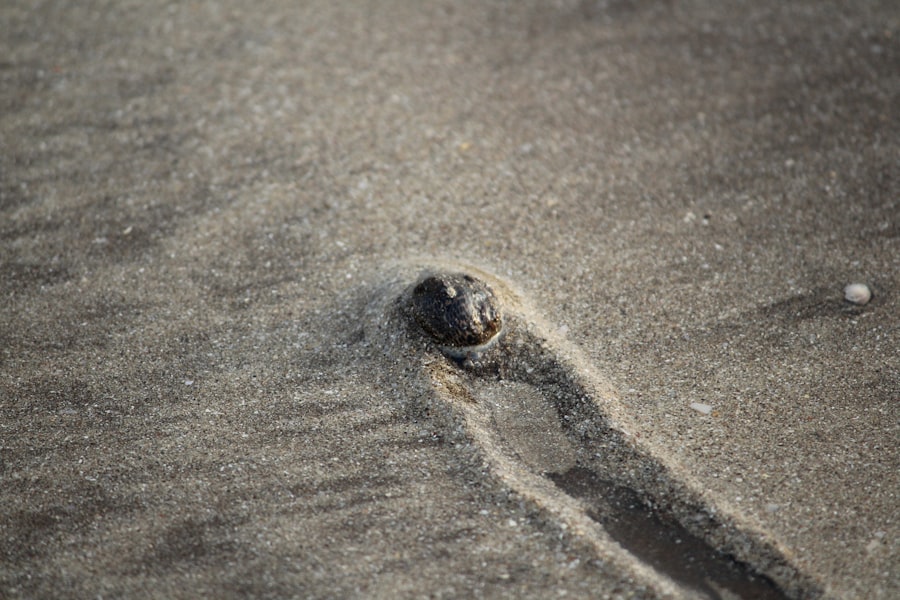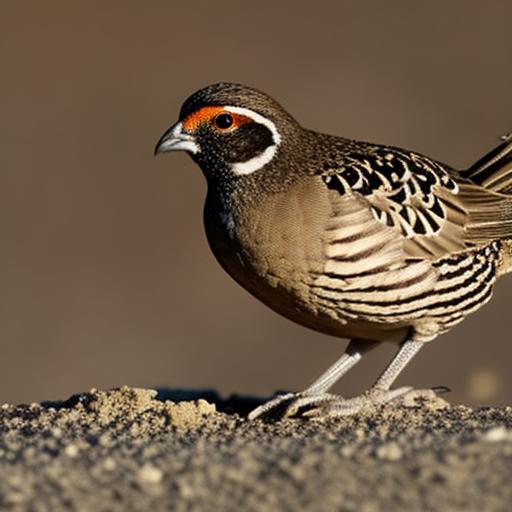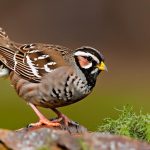Sand is an excellent choice for bedding material for quail for several reasons. Firstly, sand provides excellent drainage, which is crucial for maintaining a dry and clean environment for quail. This is especially important in preventing the growth of harmful bacteria and fungi that thrive in damp conditions. Additionally, sand is easy to clean and maintain, as droppings and other waste can be easily sifted out, leaving a clean and sanitary surface for the quail. Furthermore, sand provides a comfortable and natural substrate for quail to walk and rest on, mimicking their natural habitat and reducing the risk of foot injuries or bumblefoot.
Moreover, sand is an affordable and readily available bedding option for quail keepers. Unlike other bedding materials, such as wood shavings or straw, sand does not need to be replaced frequently, saving both time and money in the long run. Additionally, sand is non-toxic and safe for quail to ingest, reducing the risk of health issues associated with bedding materials that may contain harmful chemicals or toxins. Overall, using sand as bedding for quail provides numerous benefits, including excellent drainage, ease of cleaning, comfort for the quail, affordability, and safety.
Key Takeaways
- Sand bedding for quail provides natural insulation, cushioning, and dust bathing opportunities
- Choose fine, clean, and non-toxic sand for quail bedding to prevent foot injuries and respiratory issues
- Regularly spot clean and replace soiled sand to maintain cleanliness and prevent bacterial growth
- Dust baths are essential for quail on sand bedding to maintain healthy skin and feathers
- Potential challenges include sand ingestion and ammonia buildup, which can be addressed by providing grit and proper ventilation
- Set up a shallow sand pit and provide regular maintenance to create a comfortable and hygienic habitat for quail
- Alternatives to sand bedding include straw, wood shavings, and paper-based bedding, each with their own benefits and drawbacks
Choosing the right type of sand for quail bedding
When selecting sand for quail bedding, it is essential to choose the right type of sand to ensure the health and well-being of the birds. Firstly, it is crucial to use coarse or medium-grain sand rather than fine sand, as fine sand can compact easily and retain moisture, leading to damp and unsanitary conditions. Coarse or medium-grain sand provides better drainage and aeration, preventing the buildup of moisture and reducing the risk of bacterial and fungal growth. Additionally, it is important to choose clean, washed sand that is free from contaminants such as chemicals, debris, or pathogens that could harm the quail.
Furthermore, it is advisable to avoid using colored or dyed sand, as these may contain harmful chemicals that could be ingested by the quail. Natural, light-colored sand is the best choice for quail bedding, as it provides a safe and comfortable substrate for the birds. It is also important to ensure that the sand does not contain sharp or abrasive particles that could cause injuries to the quail’s feet or skin. Overall, choosing the right type of sand for quail bedding involves selecting coarse or medium-grain, clean, washed, natural-colored sand that is free from contaminants and abrasive particles.
How to maintain cleanliness and hygiene when using sand as bedding for quail
Maintaining cleanliness and hygiene when using sand as bedding for quail is essential for the health and well-being of the birds. Regular cleaning and maintenance are crucial to prevent the buildup of waste and pathogens that could harm the quail. One way to maintain cleanliness is by regularly sifting the sand to remove droppings, uneaten food, feathers, and other debris. This can be done using a fine mesh sieve or a specialized sand sifter designed for poultry bedding. By removing waste regularly, the sand bedding remains clean and dry, reducing the risk of bacterial and fungal growth.
In addition to regular sifting, it is important to replace soiled or damp areas of the sand bedding promptly. This prevents the spread of moisture and bacteria, ensuring a clean and sanitary environment for the quail. Furthermore, providing dust baths for the quail can help them maintain their own cleanliness by allowing them to dust themselves with dry sand, which helps to remove excess oils and parasites from their feathers and skin. By incorporating these practices into a regular cleaning routine, quail keepers can maintain cleanliness and hygiene when using sand as bedding for their birds.
The importance of providing dust baths for quail when kept on sand
Dust baths are essential for quail when kept on sand bedding as they serve several important purposes for the birds’ health and well-being. Firstly, dust baths help to control parasites such as mites and lice by suffocating them with fine particles of dust or sand. This natural method of parasite control is crucial for preventing infestations that can harm the quail and cause discomfort. Additionally, dust baths help to remove excess oils and moisture from the quail’s feathers and skin, keeping them clean and healthy.
Furthermore, dust baths provide enrichment for the quail by allowing them to engage in natural behaviors such as scratching, fluffing their feathers, and rolling in the dust. This helps to reduce stress and boredom in captive quail, promoting their overall well-being. Providing a designated area filled with fine sand or dust where the quail can take regular dust baths is essential for meeting their behavioral and hygiene needs. Overall, dust baths are an important aspect of caring for quail kept on sand bedding, as they contribute to parasite control, hygiene maintenance, and behavioral enrichment for the birds.
Potential challenges and solutions when keeping quail on sand bedding
While using sand as bedding for quail offers numerous benefits, there are also potential challenges that quail keepers may encounter when maintaining a sand-based habitat. One common challenge is the potential for the sand to become compacted over time, reducing its drainage and aeration properties. This can lead to damp conditions that are conducive to bacterial and fungal growth. To address this challenge, quail keepers can regularly fluff or turn over the sand bedding to prevent compaction and promote airflow. Adding coarse or medium-grain particles to the sand can also help maintain its structure and prevent compaction.
Another challenge when keeping quail on sand bedding is the potential for dust to be kicked up during normal bird activities such as scratching and dust bathing. This can create dusty conditions that may be harmful to both the quail and their keepers. To mitigate this challenge, quail keepers can use a dust-free or low-dust type of sand for bedding, or provide a designated dust bathing area with fine dust or sand that can contain any airborne particles. Additionally, ensuring good ventilation in the quail housing can help reduce dust buildup in the air. By addressing these potential challenges with proactive solutions, quail keepers can successfully maintain a clean and healthy environment for their birds on sand bedding.
Tips for setting up and maintaining a sand-based quail habitat

Setting up and maintaining a sand-based habitat for quail requires careful planning and attention to detail to ensure the health and well-being of the birds. When setting up the habitat, it is important to provide a sufficient depth of sand bedding to allow for natural behaviors such as dust bathing and scratching. A depth of at least 2-3 inches of sand is recommended to provide adequate substrate for these activities. Additionally, providing a designated dust bathing area filled with fine dust or sand can help contain any airborne particles and prevent excessive dust buildup in the environment.
In terms of maintenance, establishing a regular cleaning routine is essential for keeping the sand bedding clean and sanitary. This includes daily sifting of the sand to remove waste and debris, as well as prompt replacement of soiled or damp areas. It is also important to monitor the moisture levels in the sand bedding regularly to prevent compaction and maintain good drainage. Providing good ventilation in the quail housing can help reduce dust buildup in the air and promote a healthy environment for the birds. By following these tips for setting up and maintaining a sand-based quail habitat, keepers can create a comfortable and hygienic living space for their birds.
Alternatives to sand for quail bedding and their pros and cons
While sand is a popular choice for quail bedding due to its numerous benefits, there are also alternative bedding materials that quail keepers may consider based on their specific needs and preferences. One alternative to sand is wood shavings or sawdust, which provide good absorbency and cushioning for the birds. However, wood shavings may require more frequent replacement compared to sand, as they can retain moisture and odors more easily. Additionally, some types of wood shavings may contain aromatic oils that could be harmful to quail if ingested.
Another alternative bedding material is straw or hay, which provides good insulation and comfort for the birds. However, straw may be less effective in controlling moisture compared to sand, leading to damp conditions that are conducive to bacterial growth. Additionally, straw may harbor mold spores or mites that could pose health risks to the quail if not properly managed. Ultimately, each bedding material has its own pros and cons in terms of absorbency, comfort, cleanliness, and potential health risks for quail.
In conclusion, while sand offers numerous benefits as a bedding material for quail, it is important for keepers to carefully consider their specific needs and preferences when choosing a suitable bedding material for their birds. By weighing the pros and cons of different options and implementing appropriate maintenance practices, quail keepers can create a comfortable and hygienic living environment for their birds.
If you’re considering keeping quail on sand, you may also be interested in learning about the benefits of renting a chicken coop. Renting a coop can be a convenient and cost-effective option for those who want to raise chickens but may not have the space or resources to build their own coop. To find out more about this option, check out this informative article on renting a chicken coop.
FAQs
What are the benefits of keeping quail on sand?
Keeping quail on sand can provide a natural and comfortable environment for the birds. Sand allows for easy cleaning, good drainage, and can help prevent issues such as foot problems and parasites.
What type of sand is best for keeping quail?
The best type of sand for keeping quail is coarse sand or poultry sand. This type of sand allows for good drainage and is less likely to compact, which can lead to issues with moisture and odor.
How should the sand be maintained for quail?
The sand should be regularly raked and turned to prevent compaction and allow for good drainage. It should also be replaced periodically to maintain cleanliness and prevent the buildup of waste and bacteria.
Are there any potential drawbacks to keeping quail on sand?
One potential drawback of keeping quail on sand is that it may not provide enough cushioning for the birds’ feet, which could lead to foot problems. Additionally, if the sand is not properly maintained, it can become a breeding ground for parasites and bacteria.
Can quail be kept on sand in all climates?
Quail can be kept on sand in most climates, but it is important to ensure that the sand is well-draining and does not become waterlogged in wet or humid conditions. In colder climates, additional bedding or insulation may be needed to provide warmth for the birds.
Meet Walter, the feathered-friend fanatic of Florida! Nestled in the sunshine state, Walter struts through life with his feathered companions, clucking his way to happiness. With a coop that’s fancier than a five-star hotel, he’s the Don Juan of the chicken world. When he’s not teaching his hens to do the cha-cha, you’ll find him in a heated debate with his prized rooster, Sir Clucks-a-Lot. Walter’s poultry passion is no yolk; he’s the sunny-side-up guy you never knew you needed in your flock of friends!







